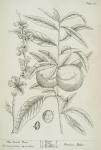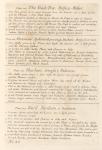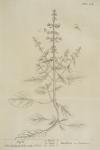

 101. The Peach Tree. Persica. Malus.
101. The Peach Tree. Persica. Malus.
Also see #101, Peach Tree - #105, Almond Tree
1. This Tree grows to no great Bigness here, the Leaves are a deep Green and the Flowers a fine Pink Colour.
2. It is planted in Gardens & flowers in March: the Fruit is ripe in August.
3. The Flowers are opening and purging, and are chiefly given to Children to carry off thin serous Humours, and to kill Worms. The Fruit is cooling and moistning, gratefull to the Palate; but apt to putrefy and cause Surfiets.
4. Greek, ωεςδικα μηλα and Ροδακηνα. Latin, Persica Malus. Spanish, Pexegos. Italian, Pesche & Persiche. French, Pesches. German, Pfersich. Dutch, .

 102. Plowman's Spikenard great Conysa. Baccharis Monspeliensium.
102. Plowman's Spikenard great Conysa. Baccharis Monspeliensium.
1. The Stalks grow to be Three foot high, the Leaves are a dull Green, the Flowers Yellow.
2. It grows on hilly chalky Places and flowers in Iuly.
3. This Plant is esteemed by some a good Vulnerary, for Bruises, Contusions, Ruptures, and Inward Wounds, Pains in ye Side & Difficulty of Breathing.
4. Greek, Κονιζα. Latin, Baccharis Monspeliensium, and Conysa major vulgaris. Spanish, Attadegua. Italian, Coniza or Pulicaria. French, Herbe aux Puces. German, Geel Munk. Dutch, .
(Henriette's comment: Baccharis Monspeliensium would properly be Nardostachys jatamansi, which doesn't look anything like the image and is unlikely to be the described plant.)

 103. Flea-Bane. Conysa & Pulicaria.
103. Flea-Bane. Conysa & Pulicaria.
1. The Stalks grow about a Span high, the Leaves are a grass Green, and the Flowers yellow.
2. It grows in moist Places, and where Water has stood all the Winter, and flowers in August and September.
3. This is the Pulicaria of Lobel, so call'd because by its Smell it destroys Fleas and Gnats. Parkinson and Gerard commend the Conysa Media as better than this.
4. Greek, Κονιζα μικρά. Latin, Conysa and Pulicaria. Spanish, Attadegua menore. Italian, Conysa minore. French, Herb aux Puces. German, Geel Munk. Dutch, .

 104. Basil. Basilicon or Ocimum.
104. Basil. Basilicon or Ocimum.
1. It grows about a foot high, the Leaves are a light Green, and the Flowers white.
2. It is sown in Gardens and flowers in Iuly and August.
3. The Ancients condemn the inward use of this Plant as hurtfull to the Sight. Schroder commends it as good to cleanse ye Lungs of Flegm, and provoke the Menses. The Leaves are used in the Aq. Hysterica and Ung. Martiatum.
The Seed is used in the Aq. Vitae comp. Syrup. Artemisiae, Pulv. Diarrhodon. See Casper Commelin p. 56.
4. Greek, Ώκιμον. Latin, Basilicon & Ocimum. Spanish, Albahaca. Italian, Basilico. French, Basilic. German, Basilien. Dutch, Basilicon.

